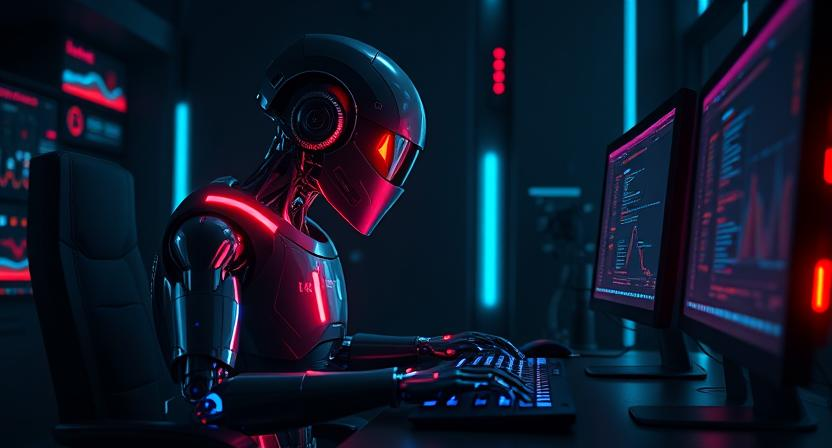Maximizing Productivity with Claude AI and Cursor IDE: A Senior Developer's Perspective

Over my 15+ years in software engineering, I've witnessed countless tools promising to revolutionize development. Most deliver incremental improvements at best. AI coding assistants are different. They're fundamentally changing how we write code—and I needed to see firsthand if they lived up to the hype.
I set out to test two leading AI coding assistants—GitHub Copilot (powered by GPT-4o) and Cursor IDE (integrated with Claude 3.5 Sonnet)—during the development of a Flutter application. My mission was clear: determine whether these tools could genuinely enhance a senior developer's productivity without compromising code quality.
What I discovered has transformed my daily workflow and might just change yours too.
The Evolution of AI Coding Assistants
We've come a long way from basic autocomplete. Today's AI coding assistants are sophisticated pair-programming partners that understand context, architecture, and best practices. The market now includes:
- GitHub Copilot: Trained on GitHub's vast code repositories
- Cursor IDE: Purpose-built editor deeply integrated with Claude AI
- Amazon CodeWhisperer: AWS's competitive offering
- Tabnine: An early entrant focused on intelligent completion
These aren't separate tools anymore—they're extensions of the IDE itself, blurring the lines between human and AI contributions in ways that were science fiction just a few years ago.
Comparative Analysis: Claude vs. GPT-4o/Copilot
My experiment began with a straightforward hypothesis: an AI trained on the world's largest code repository should excel at programming tasks. Reality proved more complex.
Expectations vs. Reality
Working with GitHub Copilot felt like pairing with a junior developer who could deliver functioning code but missed the deeper aspects of software engineering. The code worked, but examining the implementation revealed shallow solutions that ignored wider context and future maintainability.
My typical reaction to Copilot's suggestions: "Ew, you sure that's how we should do things?"
In contrast, Claude consistently produced code that reflected a deeper understanding of software engineering principles. My reaction to Claude's output was consistently: "Not bad, that's pretty close to what I expected. Good job."
The gap was so significant that I abandoned Copilot entirely midway through the project.
Code Quality and Implementation Depth
The key difference wasn't functionality—both systems generated working code. The difference was in Claude's ability to "think" more deeply about solutions, considering:
- Proper separation of concerns
- Clean file organization
- Future extensibility
- Maintainability tradeoffs
- Established best practices
For non-technical stakeholders or junior developers who prioritize "it works" over "it's built right," this distinction might seem academic. For those of us who've spent years cleaning up technical debt created by expedient but short-sighted implementation choices, it's everything.
Claude + Cursor: A Closer Look
The combination of Claude AI with Cursor IDE proved exceptionally powerful, particularly in areas where most coding assistants fall short.
Superior Requirement Understanding
Claude consistently demonstrated an impressive ability to grasp complex requirements and implement them properly. When asked to build a feature, Claude would:
- Create appropriate abstractions
- Implement robust error handling
- Consider edge cases
- Structure code for testability
This wasn't just about writing code that compiled—it was about writing code that would withstand the test of time and changing requirements.
Multi-File Project Organization
One of Claude's standout strengths was its understanding of proper project organization. Rather than stuffing functionality into bloated files, it would:
- Create separate files with clear responsibilities
- Establish clean interfaces between components
- Maintain consistent naming conventions
- Document public interfaces
The result was a codebase that felt professionally architected rather than hastily assembled—crucial for any project intended to live beyond a proof of concept.
Real-World Application: The Flutter Project Case Study
To put these tools through their paces, I built a Drive Safe monitoring application using Flutter—a framework I had limited direct experience with beyond a Mood Tracker university project.
Leveraging AI as a Senior Developer
Despite my limited Flutter-specific experience, my years in development gave me the judgment to evaluate code quality, architectural decisions, and potential issues. This created a powerful synergy: Claude handled the implementation details while I provided the oversight and direction.
The productivity gains were substantial:
- Manual component coding: ~15 minutes
- AI-assisted approach: ~6-7 minutes (1 min for prompt, 1 min for generation, 3-4 mins for review and adjustments)
This represented a consistent 50-70% reduction in development time, not counting the elimination of syntax errors and typos that would have required additional debugging.
Code Completion Effectiveness
The code completion feature was surprisingly accurate, correctly predicting my intentions 50-70% of the time. This was particularly valuable during refactoring, where the AI recognized patterns in my changes and suggested similar modifications for related code.
In some cases, Claude would anticipate my next move, suggesting the next line to edit based on previous changes—requiring only a tab press to accept. This feature alone dramatically accelerated routine coding tasks.
Limitations and Challenges
My experience wasn't without frustrations. Several limitations became apparent throughout the project.
Prompt Dependency
The quality of AI-generated code remained heavily dependent on prompt quality. Generic requests produced generic solutions, while detailed specifications yielded professional implementations.
Fortunately, as a senior developer accustomed to writing detailed specifications for junior team members, crafting effective prompts came naturally. The best approach mirrored how I'd brief a human developer:
- What needs to be built
- How it should be implemented
- Where it integrates with existing code
- Critical considerations and non-negotiables
- Potential pitfalls to avoid
Knowledge Cutoff Issues
AI knowledge cutoffs created real challenges when working with rapidly evolving frameworks. Throughout the project, I encountered multiple instances where Claude suggested approaches that had become outdated.
When working on a Laravel 12 backend, Claude consistently recommended Laravel 11 methods. This required vigilant cross-checking with current documentation to ensure the generated code followed best practices.
Debugging Limitations
When bugs inevitably appeared, Claude showed limitations in diagnosing and resolving them. In these scenarios, I had to take a more active role in debugging while using Claude more as an implementation assistant.
This reinforced an important reality: AI coding assistants remain tools for skilled developers rather than autonomous code generators. Their value lies in accelerating implementation, not replacing the critical thinking required for solving complex problems.
The Role of AI in the Developer Ecosystem
My experience raises important questions about AI's impact on our profession.
Will AI Replace Developers?
Based on my direct experience, the answer is nuanced:
- For senior developers: No. While AI accelerates implementation, it lacks the judgment, architectural vision, and experience-based intuition that senior developers provide.
- For junior developers: Partially. AI can now generate code at a level comparable to good junior developers when given proper direction.
Learning Considerations
I have genuine concerns about junior developers becoming overly dependent on AI. The struggle of solving problems is how we develop programming intuition and judgment. Relying too heavily on AI-generated solutions could hamper this essential growth.
I still believe juniors should write code manually during their formative years. The foundations built through hands-on experience create the judgment needed to effectively leverage AI tools later in their careers.
Best Practices for AI-Assisted Development
Based on my experience, here are concrete strategies for maximizing AI coding assistants:
Craft Specific Prompts
Approach prompt writing as you would a detailed specification. Include:
- Clear functionality requirements
- Architectural expectations
- Integration points with existing code
- Performance considerations
- Edge cases to handle
Generic prompts produce generic results. The time invested in detailed prompts pays immediate dividends in output quality.
Implement Rigorous Review Processes
Never accept AI-generated code uncritically. Establish a consistent review process:
- Evaluate architectural soundness
- Check for security vulnerabilities
- Validate against current documentation
- Test edge cases
- Consider performance implications
Remember: you're still responsible for every line that goes into production, regardless of who—or what—wrote it.
Use AI for Ideation and Validation
One unexpected benefit was using Claude as a technical sounding board. When debating implementation approaches, I could ask Claude to:
- Compare alternative solutions
- Outline pros and cons of different patterns
- Recommend approaches based on my requirements
This served as a sophisticated "rubber duck" with technical knowledge, helping validate my thinking or identify considerations I might have overlooked.
Cross-Check with Current Documentation
When working with evolving frameworks, always verify AI suggestions against current documentation. This is particularly important for:
- API changes in new library versions
- Deprecated methods or approaches
- Framework-specific best practices
Looking Forward: The Future of AI in Software Development
As these tools continue to evolve, I anticipate several developments:
- Improved contextual understanding: Future models will better comprehend entire codebases and project architectures
- Enhanced debugging capabilities: AI will become more effective at identifying and fixing issues in generated code
- Real-time adaptation to library changes: Models will stay current with framework and library updates
- More sophisticated architectural reasoning: AI will provide deeper insights into system design tradeoffs
However, I believe the fundamental relationship will remain unchanged—AI as an accelerator for skilled developers rather than a replacement for human judgment.
Key Takeaways
After integrating AI coding assistants into my daily workflow, several clear lessons emerged:
- AI coding assistants are tools, not replacements: They excel at implementation but require human oversight for quality and architectural coherence.
- Senior developers benefit most from current AI capabilities: The ability to judge code quality and provide detailed direction makes senior developers ideal partners for AI coding tools.
- Prompt quality directly determines output quality: Investing time in crafting detailed prompts yields dramatically better results than vague requests.
- Cross-verification remains essential: Always validate AI-generated code against current documentation and best practices.
- AI transforms the development process: Rather than eliminating skilled developers, AI shifts our focus toward higher-level architecture, quality control, and critical decision-making.
For experienced developers willing to adapt their workflow, AI coding assistants represent an opportunity to significantly increase productivity while maintaining high standards. Rather than fearing these tools, we should embrace them as extensions of our capabilities—allowing us to focus more on the creative and architectural aspects that truly require human insight.
The future isn't about AI replacing developers—it's about finding the optimal partnership between human judgment and AI acceleration. I've found mine. Have you discovered yours?
